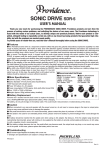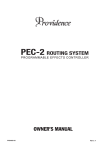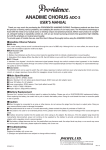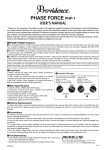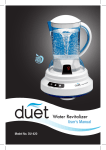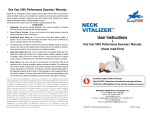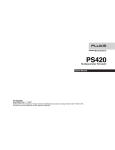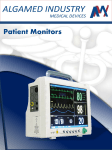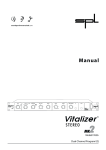Download products manual - Providence
Transcript
CHRONO DELAY DLY-4 OWNER’S MANUAL Thank you for choosing Providence. In order to take full advantage of the product’s features and performance, please read this manual thoroughly and keep it in a safe place for future reference. ■Main Features ●Delay time is adjustable from 1 to 2700 milliseconds. The current delay time is accurately shown on the 4-digit 7-segment LED display. ●Delay time can be displayed in milliseconds (mSec) or beats per minute (BPM). The BPM display is not simply a “rough estimate.” BPM delay times are displayed with metronome accuracy. ●The delay time can be precisely set according to the tempo tapped on the TAP footswitch. ●The A/B preset memory allows two different delay times settings to be memorized and recalled via the footswitch as needed. ●With the specified delay time as a quarter-note reference, seven delay time variations ranging from half notes to sixteenth-note can be directly selected via the BEAT SPLIT selector. Rhythm-based delay time settings that previously required tedious calculations can now be made in an instant. ●Both the VITALIZER® that prevents degradation of the direct signal and the mixer that combines the direct signal with the delay signal are analog circuits that have been designed and built to the highest possible sonic standards. ●A momentary, non-latching type footswitch can be connected to the EXT.TAP jack to allow remote tap delay operation. When this function is used the A/B – TAP footswitch on the CHRONO DELAY unit is dedicated to A/B preset switching, so that tap delay and A/B preset switching operation are simultaneously available via separate footswitches. ●The DLY-4 CHRONO DELAY features a simple interface that allows fast, intuitive control. 〔About VITALIZER®〕The VITALIZER® circuit was developed to counteract the signal degradation that normally occurs in guitar and bass processing systems. The characteristics of the VITALIZER® circuit continuously adapt to the instrument's output, ensuring that the instrument's natural characteristics are transmitted without degradation or compromise. ■Controls & Functions (refer to the panel illustration) ①MIX: Adjusts the amount of delay sound that is mixed with the direct sound. ②ECHO HARDNESS: Adjusts the level of the mid and high frequency components of the delay sound. When feedback is applied via the FEED BACK control, the mid and high frequencies decay a little more with each repeat. This makes it possible to create natural sounding echo effects, as well as simulate the sound of tape echo or analog delay effects. ③FEED BACK: Adjusts the amount of delay signal “fed back” to the DLY-4 input. Higher FEED BACK levels produce longer series of decaying repeats. Turing the FEED BACK level up too high can result in oscillation. ④TIME: Sets the delay time. Delay time can be adjusted in either 1 BPM (Beats Per Minute) or 1 mSec (millisecond) steps, according to the selected display mode. Rotate the control rapidly for faster adjustment in increments of 10 rather than 1. *The delay time range depends on the selected display mode: ・mSec mode:1~2700mSec ・BPM mode:45~300BPM (quarter-note beats) *Smaller BPM values result in longer delay times. ⑤BEAT SPLIT: Allows the delay time to be instantly switched to a variety of note lengths, using the set delay time as a quarter-note reference. With the selector in the “6 o’clock” position the delay time will correspond directly to the set “quarter note” time. The other available settings are, in sequence: half note, half-note triplet, dotted eighth note, quarter-note triplet, eighth-note, eighth-note triplet, and sixteenth note. *When the mSec display mode is selected the delay time display will change according to the BEAT SPLIT setting. The delay time display will not change according to the BEAT SPLIT setting when the BPM display mode is selected, and will continue to show the reference quarter-note value. ⑥BPM – mSec Toggle Switch: Switches between the BPM and mSec display mode. ・BPM (Beats Per Minute):Displays the delay time in beats-per-minute tempo format. ・mSec (milliseconds):Displays the delay time in milliseconds. *If the delay time was set in milliseconds or via the TAP function, BPM will be displayed to the nearest beat value. *Although the DLY-4 is capable of producing delay times from 1 through 2700 milliseconds, the BPM display range is somewhat narrower. If a delay time that is outside the BPM display range is initially set via the mSec mode and then the BPM display mode is selected, the actual delay time will remain unchanged but no BPM value will be shown (“----“ will appear on the display). ⑦A/B – TAP Toggle Switch: Selects the operation mode of the A/B – TAP footswitch (see “⑨A/B – TAP Footswitch:” below). ⑧ON/OFF Footswitch: This footswitch normally turns the delay effect ON or OFF. Pressing and holding the footswitch for longer than 2 seconds to engages the preset memory registration mode (see “A/B Preset Memory Operation” below). ⑨A/B – TAP Footswitch: The operation of this footswitch depends on the setting of the A/B – TAP toggle switch, as follows: ■A/B Mode (A/B Preset memory switching):The footswitch alternately recalls the memorized A and B delay time settings. ■TAP Mode (Tape tempo entry):The delay time is set according to the tempo at which the footswitch is tapped. * When an external TAP footswitch is connected to the EXT.TAP jack, the footswitch functions in A/B mode only. ⑩LED Delay Time Display: Numerically displays the current delay time. When a delay time is entered via the TAP function or when the display mode is switched, delay time increments smaller than 1 millisecond are indicated by a dot to the lower right of the 1’s digit on the display. ⑪Timing Indicator: This LED indicator flashes at the current delay time/tempo. ⑫ON/OFF LED: Lights blue when the effect is ON. Flashes when the A/B preset memory registration mode is engaged. ⑬A/B – TAP LED: Lights red when the TAP mode is selected. Lights green when preset memory A is selected. Lights orange when preset memory B is selected. ⑭INPUT Jack: This is the input to the DLY-4. The output from a guitar or other source device (electronic musical instrument or effect unit) should be connected here. ⑮OUTPUT Jack: This is the output from the DLY-4. The OUTPUT jack should be connected to an amplifier, a subsequent effect device, or the return jack of the effect loop on an instrument or audio device. When the effect is turned ON the delay sound is mixed with the direct sound and output via this jack. ⑯EXT.TAP Jack: An external momentary (non-latching) footswitch can be connected to this jack via a standard mono phone jack instrument cable. When an appropriate footswitch is connected, the A/B – TAP toggle switch on the DLY-4 will become inactive: the external footswitch can be used for TAP delay time entry, while the A/B – TAP footswitch on the DLY-4 can be used to switch between the A and B preset memories. ⑰DC12V INPUT: The DC output cable from the supplied AC adaptor connects here. ■A/B Preset Memory Operation Example: Memorize a quarter-note delay time of 120 BPM (500 mSec). 1) Set the BEAT SPLIT selector to its “6 o’clock” position:♩= quarter note. 2) Set the A/B – TAP toggle switch to TAP. 3) Use the BPM – mSec toggle switch to select either the BPM or mSec dis- play mode. • If you select the BPM mode, use the TIME control to set a tempo of 120. • If you select the mSec mode, use the TIME control to set a delay time of 500 milliseconds. You can also set the delay time using the TAP function. 4) Press and hold the ON/OFF footswitch for longer than 2 seconds. The blue LED will flash indicating that the preset memory registration mode is engaged. 5) Set the A/B – TAP toggle switch to A/B. 6) Press the A/B – TAP footswitch to select memory A (LED = green) or memory B (LED = orange). 7) Press and hold the ON/OFF for longer than 2 seconds again, and when the blue LED lights continuously the preset procedure for that memory is complete. *Whenever a new delay time is stored in a preset memory, the new delay time replaces the previous setting in that memory. Make sure that you want to erase and replace the existing setting before memorizing a new delay time. *The settings of the BPM – mSec toggle switch and BEAT SPLIT selector are not stored in memory. The BEAT SPLIT selector will need to be set to the position at which the delay time was memorized in order to recall the exact same delay time. *The preset memory registration mode can be disengaged at any time by pressing the ON/OFF footswitch once briefly (less than 2 seconds). *“BPM” stands for “Beats Per Minute,” and is a standard term used to express performance tempo. BPM usually refers to the number of quarter notes per minute. Example: 1 beat (♩) at a BPM of 120 lasts for 500 milliseconds. 60 (seconds) ÷ 120 (BPM) = 0.5 seconds (500 milliseconds). ■Specifications • Controls: MIX, ECHO HARDNESS, FEED BACK, TIME, BEAT SPLIT, BPM – mSec toggle switch, A/B – TAP toggle switch, ON/OFF footswitch, A/B – TAP footswitch. • Connectors: Standard ¼ inch phone jacks (INPUT, OUTPUT, EXT.TAP, DC 12V) • Power Supply: Supplied AC adaptor (PAP-712DCJ for North America and Japan, PAP-712DCE for Europe, PAP-712DCU for UK). • Power Consumption: DC12V, <110mA • Dimensions (D x W x H): 122 x 101 x 58 mm • Weight: Approx 410 grams, not incl. AC adaptor. ■Precautions • Use only the supplied AC adaptor to power the DLY-4 CHRONO DELAY. • Do not plug/unplug the INPUT jack while the DLY-4 is connected to an amplifier or other device that is connected to speakers and powered up. The noise produced when plugging/unplugging cables can damage the speakers. • If a malfunction or abnormal operation occurs, cease operation of the device immediately and contact Pacifix, Ltd. or the dealer from which the device was purchased. *Specification and appearance are subject to change without notice. PPD0908-01 Rev 1.0



